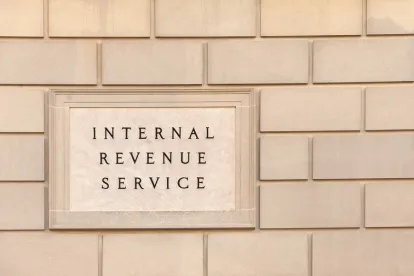New guidance from the Internal Revenue Service (IRS, the Service) extends the Continuity Safe Harbor to 10 years for both offshore wind projects and projects on federal land.
IN DEPTH
As background, eligibility for the production tax credit (PTC) under Section 45 and the investment tax credit (ITC) under Section 48 ties to the date when a project “begins construction.” There is extensive existing guidance from the Service regarding when a project is treated as having begun construction. Broadly speaking, a project is treated as having begun construction when it meets either the Physical Work Test (performing physical work of a significant nature) or the Five Percent Safe Harbor (spending 5% of the total cost of the project). In addition, the taxpayer must satisfy certain continuity requirements with respect to the project. The Service has provided a “Continuity Safe Harbor,” whereby a project is treated as satisfying the continuity requirements if it is placed in service by the end of the year that is four years after the year when the Physical Work Test or Five Percent Safe Harbor is met. The Continuity Safe Harbor had previously been extended to five years for projects that met the Physical Work Test or Five Percent Safe Harbor in 2016 or 2017.
At the end of 2020, the new stimulus bill was passed into law, and it included several provisions relating to the PTC and ITC. Read our summary of the new law here. The law also provided a standalone ITC for offshore wind projects. The offshore wind ITC is 30% for any projects where construction begins before 2026 and is not subject to any phase down. Qualified facilities are those located in the inland navigable waters of the United States or in the coastal waters of the United States. The existing Service guidance should apply for determining when an offshore wind facility is treated as having begun construction.
On Monday, the Service issued Notice 2021-05 (the Notice). The Notice provides that for “Offshore Projects” or “Federal Land Projects,” the Continuity Safe Harbor is extended to 10 years. That is, a project will be treated as having begun construction in the year when it first meets the Physical Work Test or Five Percent Safe Harbor, so long as the project is placed in service by the end of the year that is 10 years after the year when the Physical Work Test or Five Percent Safe Harbor is met. “Offshore Project” means a qualified facility in inland navigable waters of the United States or any coastal waters of the United States (i.e., those projects that are eligible under the new offshore wind ITC), which will require the construction of one or more high-voltage transmission lines to connect to the grid. “Federal Land Project” means a project more than 50% of which will be placed in service on land owned or controlled by the United States, as determined by relative value or relative area, which will require the construction of one or more high-voltage transmission lines to connect to the grid.
The Service indicated that the Notice relief was provided because it was “aware of certain qualified facilities and energy property that are begin constructed Offshore or on Federal Land,” and based on comments from Congress and project stakeholders, it determined that these projects ordinarily are subject to significantly greater delays than other projects, and are at higher risk of failing the Continuity Safe Harbor. The Service noted that these delays may otherwise fall within the list of excusable disruptions under the existing guidance, for purposes of determining if the projects otherwise meet the facts and circumstances continuity requirement (i.e., if the project does not satisfy the Continuity Safe Harbor).
The relief applies to offshore wind projects (which are newly eligible for a standalone ITC), as well as any ITC or PTC projects on federal land (e.g., solar, fuel cell, onshore wind, etc.). However, under the ITC statute in Section 48, ITC projects other than offshore wind are generally subject to “placed in service” deadlines. The Notice does not change those deadlines. For example, a solar ITC Federal Land Project that began construction in 2019 must still be placed in service by the end of 2025 to qualify for the full 30% ITC. If it is placed in service in 2026 (even though still within the 10-year Continuity Safe Harbor), it is presumably only eligible for 10% ITC under the statute. Neither the PTC nor the new offshore wind ITC is subject to a placed in service cliff, and thus these projects have more potential to benefit from the Notice. For example, an offshore wind project that begins construction in 2025 may be placed in service as late as 2035 and still be eligible for the new 30% offshore ITC.
The relatively quick release of the Notice following enactment of the offshore wind ITC last week suggests strong support for these projects by Congress, the US Department of the Treasury and Service. For instance, the offshore wind ITC remains in place, at a full 30%, through the end of 2025, while the PTC and ITC applicable to all other renewable technologies (e.g., solar, fuel cell, onshore wind, etc.) are already subject to phase down, and in the case of onshore wind, disappear for projects that start construction after 2021.
The Notice confirms that it clarifies and modifies all existing begin construction guidance for both the PTC and ITC.





 />i
/>i

